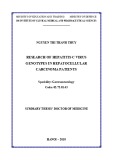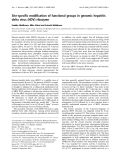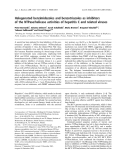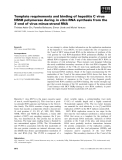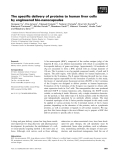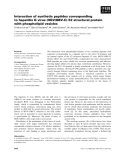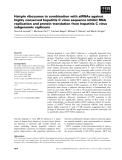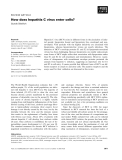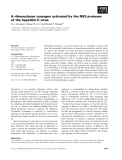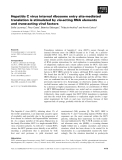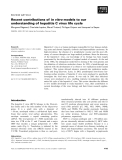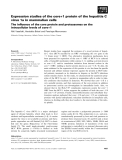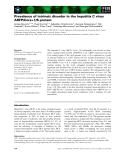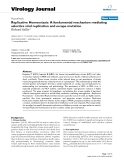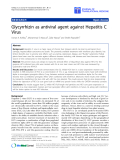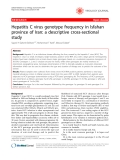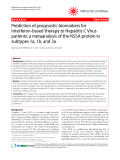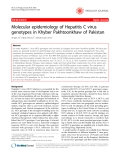
Hepatitis C virus
-
This research aiming to: Describing clinical and characteristics laboratory features and identifying HCV genotype on patients of HCC. Evaluating relationship between HCV genotypes and some clinical characteristics laboratory features,on patients of HCC.
 27p
27p  slimzslimz
slimzslimz
 21-12-2019
21-12-2019
 30
30
 9
9
 Download
Download
-
Human hepatitis delta (HDV) ribozyme is one of small ribozymes, such as hammerhead and hairpin ribozymes, etc. Its secondary structure shows pseudoknot structure com-posed of four stems (I to IV) and three single-stranded regions (SSrA, -B and -C). The 3D structure of 3¢-cleaved product of genomic HDV ribozyme provided extensive information about tertiary hydrogen bonding interactions between nucleotide bases, phosphate oxygens and 2¢OHs including new stem structure P1.1.
 12p
12p  tumor12
tumor12
 22-04-2013
22-04-2013
 38
38
 3
3
 Download
Download
-
A search has been initiated for lead inhibitors of the non-structural protein 3 (NS3)-associated NTPase/helicase activities of hepatitis C virus,the related West Nile virus, Japanese encephalitis virus and the human mitochondrial Suv3 enzyme. Random screening of a broad range of unre-lated low-molecular mass compounds,employing both RNA and DNA substrates, revealed that 4,5,6,7-tetra-bromobenzotriazole (TBBT) hitherto known as a potent highly selective inhibitor of protein kinase 2,is a good inhibitor of the helicase,but not NTPase,activity of hepa-titis C virus NTPase/helicase. ...
 9p
9p  fptmusic
fptmusic
 16-04-2013
16-04-2013
 41
41
 4
4
 Download
Download
-
In our attempt to obtain further information on the replication mechanism of the hepatitis C virus (HCV), we have studied the role of sequences at the 3¢-end of HCV minus-strand RNA in the initiation of synthesis of the viral genome by viral RNA-dependent RNA polymerase (RdRp). In this report, we investigated the template and binding properties of mutated and deleted RNA fragments of the 3¢-end of the minus-strand HCV RNA in the presence of viral polymerase.
 15p
15p  fptmusic
fptmusic
 11-04-2013
11-04-2013
 53
53
 3
3
 Download
Download
-
A bio-nanocapsule (BNC), composed of the surface antigen (sAg) of the hepatitis B virus, is an efficient nanomachine with which to accomplish the liver-specific delivery of genes and drugs. Approximately 110 molecules of sAg are associated to form a BNC particle with an average diameter of 130 nm. TheLprotein is an sAg peptide composed mainly of preS and S regions. The preS region, with specific affinity for human hepatocytes, is localized in the N-terminus.
 10p
10p  fptmusic
fptmusic
 11-04-2013
11-04-2013
 37
37
 2
2
 Download
Download
-
The interaction with phospholipid bilayers of two synthetic peptides with sequences corresponding to a segment next to the native N-terminus and an internal region of the E2 structural hepatitis G virus (HGV⁄GBV-C) protein [E2(7–26) and E2(279–298), respectively] has been characterized. Both peptides are water soluble but associate spontaneously with bilayers, showing higher affinity for anionic than zwitterionic membranes.
 11p
11p  awards
awards
 06-04-2013
06-04-2013
 38
38
 2
2
 Download
Download
-
Chronic hepatitis C virus (HCV) infection is a clinically important liver disease with limited therapeutic options in a significant proportion of patients. Therefore, novel efficient therapeutic agents are needed. Because the 5¢- and 3¢-untranslated regions (UTRs) of HCV are highly conserved and functionally important for HCV replication, they are attractive targets for RNA-cleaving ribozymes or small interfering RNAs (siRNAs).
 13p
13p  dell39
dell39
 27-03-2013
27-03-2013
 52
52
 5
5
 Download
Download
-
Hepatitis C virus (HCV) exists in different forms in the circulation of infec-ted people: lipoprotein bound and lipoprotein free, enveloped and non-enveloped. Viral particles with the highest infectivity are associated with lipoproteins, whereas lipoprotein-free virions are poorly infectious.
 15p
15p  inspiron33
inspiron33
 25-03-2013
25-03-2013
 31
31
 4
4
 Download
Download
-
Translating proteases as inactive precursors, or zymogens, protects cells from the potentially lethal action of unregulated proteolytic activity. Here, we impose this strategy on bovine pancreatic ribonuclease (RNase A) by creating a zymogen in which quiescent ribonucleolytic activity is activated by the NS3 protease of the hepatitis C virus.
 9p
9p  inspiron33
inspiron33
 23-03-2013
23-03-2013
 37
37
 4
4
 Download
Download
-
Translation initiation of hepatitis C virus (HCV) occurs through an internal ribosome entry site (IRES) located at its 5¢-end. As a positive-stranded RNA virus, HCV uses its genome as a common template for translation and replication, but the coordination between these two pro-cesses remains poorly characterized.
 19p
19p  galaxyss3
galaxyss3
 07-03-2013
07-03-2013
 35
35
 5
5
 Download
Download
-
This study of the full-length bifunctional nonstructural protein 3 from hep-atitis C virus (HCV) has revealed that residues in the helicase domain affect the inhibition of the protease. Two residues (Q526 and H528), appar-ently located in the interface between the S2 and S4 binding pockets of the substrate binding site of the protease, were selected for modification, and three enzyme variants (Q526A, H528A and H528S) were expressed, puri-fied and characterized.
 8p
8p  media19
media19
 05-03-2013
05-03-2013
 34
34
 4
4
 Download
Download
-
Hepatitis C virus is a human pathogen responsible for liver diseases includ-ing acute and chronic hepatitis, cirrhosis and hepatocellular carcinoma. Its high prevalence, the absence of a prophylactic vaccine and the poor effi-ciency of current therapies are huge medical problems. Since the discovery of the hepatitis C virus, our knowledge of its biology has been largely punctuated by the development of original models of research.
 14p
14p  media19
media19
 04-03-2013
04-03-2013
 33
33
 3
3
 Download
Download
-
Toll-like receptors and RNA helicase family members [retinoic acid-inducible gene I (RIG-I) and melanoma differentiation associated gene-5 (MDA5)] play important roles in the induction of interferon-bas a major event in innate immune responses after virus infection. TRIF (adaptor pro-tein of Toll-like receptor 3)-mediated and Cardif (adaptor protein of RIG-I or MDA5)-mediated signaling pathways contribute rapid induction of interferon-bthrough the activation of interferon regulatory factor-3 (IRF-3)....
 16p
16p  media19
media19
 04-03-2013
04-03-2013
 38
38
 3
3
 Download
Download
-
Recent studies have suggested the existence of a novel protein of hepati-tis C virus (HCV) encoded by an ORF overlapping the core gene in the +1 frame (core+1 ORF). Two alternative translation mechanisms have been proposed for expression of the core+1 ORF of HCV-1a in cultured cells; a frameshift mechanism within codons 8–11, yielding a protein known as core+1⁄F, and⁄or translation initiation from internal codons in the core+1 ORF, yielding a shorter protein known as core+1⁄S.
 18p
18p  media19
media19
 04-03-2013
04-03-2013
 33
33
 3
3
 Download
Download
-
The hepatitis C virus (HCV) Core+1/S polypeptide, also known as alter-native reading frame protein (ARFP)/S, is an ARFP expressed from the Core coding region of the viral genome. Core+1/S is expressed as a result of internal initiation at AUG codons (85–87) located downstream of the polyprotein initiator codon, and corresponds to the C-terminal part of most ARFPs.
 16p
16p  mobifone23
mobifone23
 18-01-2013
18-01-2013
 32
32
 3
3
 Download
Download
-
Tuyển tập báo cáo các nghiên cứu khoa học quốc tế ngành hóa học dành cho các bạn yêu hóa học tham khảo đề tài: Hepatitis C (HCV), hepatitis B (HBV), the human immunodeficiency viruses (HIV), and other viruses that replicate via RNA intermediaries,
 14p
14p  dauphong6
dauphong6
 05-01-2012
05-01-2012
 75
75
 8
8
 Download
Download
-
Tuyển tập báo cáo các nghiên cứu khoa học quốc tế ngành hóa học dành cho các bạn yêu hóa học tham khảo đề tài: Glycyrrhizin as antiviral agent against Hepatitis C Virus
 7p
7p  dauphong6
dauphong6
 05-01-2012
05-01-2012
 63
63
 7
7
 Download
Download
-
Tuyển tập báo cáo các nghiên cứu khoa học quốc tế ngành y học dành cho các bạn tham khảo đề tài: Hepatitis C virus genotype frequency in Isfahan province of Iran: a descriptive cross-sectional study
 6p
6p  dauphong3
dauphong3
 26-12-2011
26-12-2011
 57
57
 6
6
 Download
Download
-
Tuyển tập báo cáo các nghiên cứu khoa học quốc tế ngành y học dành cho các bạn tham khảo đề tài: Prediction of prognostic biomarkers for Interferon-based therapy to Hepatitis C Virus patients: a metaanalysis of the NS5A protein in subtypes 1a, 1b, and 3a
 9p
9p  dauphong3
dauphong3
 26-12-2011
26-12-2011
 50
50
 5
5
 Download
Download
-
Tuyển tập báo cáo các nghiên cứu khoa học quốc tế ngành y học dành cho các bạn tham khảo đề tài: Molecular epidemiology of Hepatitis C virus genotypes in Khyber Pakhtoonkhaw of Pakistanb
 7p
7p  dauphong3
dauphong3
 26-12-2011
26-12-2011
 45
45
 5
5
 Download
Download
CHỦ ĐỀ BẠN MUỐN TÌM








